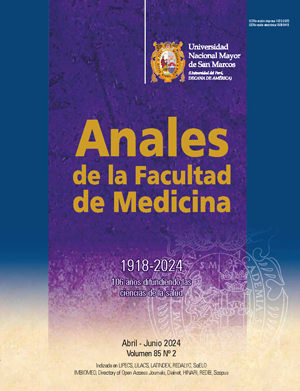Caracterización molecular y resistencia antimicrobiana de Vibrio cholerae en Perú, 1991 - 2019
DOI:
https://doi.org/10.15381/anales.v85i2.28433Palabras clave:
Vibrio cholerae, Pruebas de Sensibilidad Microbiana, Integrasas, Integrones, Farmacorresistencia MicrobianaResumen
Introducción. Los integrones presentes en Vibrio cholerae son de interés en salud pública debido a su relación con la multirresistencia a los antimicrobianos. Objetivo. Realizar una caracterización molecular, establecer la presencia de integrones y evaluar la resistencia antimicrobiana de cepas de Vibrio cholerae de origen clínico y ambiental aisladas en Perú durante los años 1991 al 2019. Métodos. Se evaluaron 34 cepas de Vibrio cholerae de origen clínico y ambiental aisladas durante los años 1991 - 2019. Todas las cepas fueron reactivadas, luego sembradas en TCBS y en medios diferenciales para su identificación taxonómica. Se realizó un antibiograma a todas las cepas según el método disco difusión utilizando 16 antimicrobianos de uso clínico. Se procedió a la extracción del ADN genómico, luego se realizó la caracterización molecular por PCR y posteriormente los productos amplificados de las integrasas fueron secuenciados. Resultados. Todas las cepas evaluadas mostraron sensibilidad de 100% (n=34) para FEP, CTX, CAZ, CIP y CN. Los antimicrobianos que exhibieron mayor resistencia fueron AMPR [26,5% (n=9)] y FZR [23,5% (n=8)]. En el presente estudio se establecieron 8 antibiotipos. Todas las cepas presentaron el gen intl4, excepto las de origen ambiental. Todas las integrasas de tipo IV tuvieron alta homología. Conclusión. Vibrio cholerae presenta un incremento en la resistencia antimicrobiana. El serogrupo O1 tuvo presencia de la integrasa de clase IV, así como una alta homología.
Descargas
Publicado
Número
Sección
Licencia
Derechos de autor 2024 Anales de la Facultad de Medicina

Esta obra está bajo una licencia internacional Creative Commons Atribución-NoComercial-CompartirIgual 4.0.
Aquellos autores/as que tengan publicaciones con esta revista, aceptan los términos siguientes:
- Los autores/as conservarán sus derechos de autor y garantizarán a la revista el derecho de primera publicación de su obra, el cuál estará simultáneamente sujeto a la Licencia de reconocimiento de Creative Commons que permite a terceros compartir la obra siempre que se indique su autor y su primera publicación esta revista.
- Los autores/as podrán adoptar otros acuerdos de licencia no exclusiva de distribución de la versión de la obra publicada (p. ej.: depositarla en un archivo telemático institucional o publicarla en un volumen monográfico) siempre que se indique la publicación inicial en esta revista.
- Se permite y recomienda a los autores/as difundir su obra a través de Internet (p. ej.: en archivos telemáticos institucionales o en su página web) antes y durante el proceso de envío, lo cual puede producir intercambios interesantes y aumentar las citas de la obra publicada. (Véase El efecto del acceso abierto).



